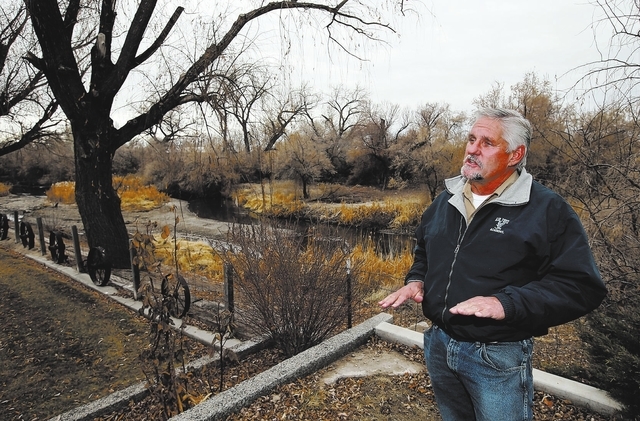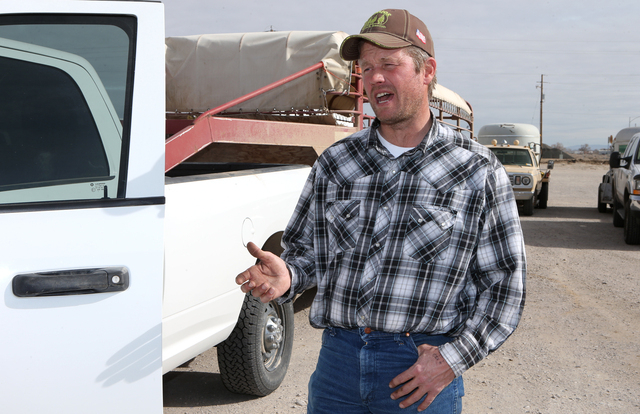Third year of drought hitting Nevada’s farms, ranches hard
FALLON — Nevada’s severe drought is a tragedy unfolding in slow motion. But its effects will be far reaching — from rural communities that depend on ranching and agriculture for their existence to the prices we all pay for food at the grocery store.
Nevada’s wildlife will suffer as food supplies disappear and springs dependent on runoff from snowfall fail. Wild horses will suffer from a lack of forage.
Wildfires could become a major problem throughout the state, from the dry rangelands to the drought-crippled forests of the Sierra Nevada.
But most of all it will be felt by the ranchers and farmers and their families, those eternal optimists who prepare the fields and grow their cattle herds every year with fingers crossed that the rain and snow will come on time.
THIRD YEAR OF DROUGHT
For the third year in a row, the rain and snow has not come on time. A wet winter storm hit Northern Nevada on Thursday for the first time this year but the long-term outlook remains uncertain and the window of opportunity continues to diminish.
A Jan. 10 report on the snowpack in Nevada showed 62 percent of normal in eastern Nevada, but only 18 percent in the Truckee River region, 28 percent in Carson and a dismal 19 percent in the Walker River drainage.
Some longtime ranchers and farmers say the current drought is the worst they have ever seen.
Because of the stingy snowpack through much of the West, federal officials this past month designated portions of 11 Western and Central states as primary natural disaster areas.
The entire state of Nevada is included because counties adjacent to those that are affected are also eligible for assistance, which comes primarily in the form of low-interest emergency loans from the U.S. Department of Agriculture.
Fallon’s agricultural and ranching communities are at ground zero of the drought, along with their neighbors in Lovelock and Yerington.
Some Nevada ranchers have already sold some of their cattle, primarily to their counterparts in the Midwest, where there are healthy grazing lands. The sales are mostly a precautionary move to take advantage of high cattle prices and to reduce herds if normal water deliveries don’t materialize.
Alfalfa is Nevada’s largest crop, with just more than 1 million tons worth $217 million produced in 2012. Cattle and dairy cows are also important. There were 470,000 cattle and 29,000 dairy cows in Nevada in 2012, the state Agriculture Department reports.
“People are starting to get nervous,” said Monte Bruck, manager of the Fallon Livestock Exchange. “We’re going to see some herd reductions. We’ve started to see some already.”
PRECAUTIONS AT THE AUCTIONS
The exchange has an auction every Tuesday as ranchers prepare for drought conditions this summer.
On a recent Tuesday, about 400 cattle from around the state and even neighboring California were up for auction at the yard. California is getting hit just as hard in this drought.
Bruck handled the auction of calves and cows, selling the animals quickly to about 50 assembled buyers.
Mike Stremler had just brought in six cows for auction from his family-owned Jersey Valley Cattle Co. ranch near Austin.
“We’re preparing for the worst,” he said as he fixed a flat tire on his trailer.
Stremler said he is trying to hold onto his herd of 400 cattle by leasing some private pasture land near Denio near the border of Oregon.
He has several U.S. Bureau of Land Management allotments to graze his cattle but is concerned they won’t be allowed on the land because of a lack of forage.
“The BLM is coming Thursday to do a drive-through,” Stremler said. “If we don’t’ get any rain by mid-March we’ll be in trouble.”
Stremler said he could survive the drought more easily if the BLM would do its job of managing the wild horse herds and spending a portion of the money it gets from grazing herds to make the range more sustainable as it is supposed to do.
Instead the agency is managing crises, he said.
BLM COULD LIMIT GRAZING
BLM spokeswoman Kaitlin Godbey said there is the potential for grazing restrictions on Nevada’s public lands this year if monitoring shows resource damage would occur at permitted grazing levels. Options range from reducing livestock numbers to reducing the length of grazing periods to closing allotments.
In response to the criticisms about BLM actions on range management spending, Godbey said Nevada spent $1.1 million out of $1.3 million on improvement projects in 2013, including fencing, noxious weed control, water developments, seeding areas and maintenance of existing improvements. The agency had no comment on the wild horse management criticisms.
Stremler said if he had not paid for his herd already it might be tough to make it through this year. High prices now being paid help offset some of the effects of the drought, he said.
Down the road from the auction yard, longtime Fallon farmer Norman Frey said he expects to receive no more than 25 percent of his water allocation this year, reducing the amount of alfalfa he can grow to a fraction of his 900 acres.
“We’ll probably be out of water by July 1,” he said.
LIFEBLOOD OF RURAL NEVADA
Frey said many people nowadays don’t seem to understand the connection between alfalfa and food production, or the relationship between farms and the food they buy in the grocery store.
Nevadans who don’t get out to the rural areas of the state very often may not know it but ranching and agriculture are one of the largest industries in the state, contributing $3.3 billion directly to the state economy, said Bob Conrad, a Nevada Department of Agriculture spokesman.
The industries are the lifeblood of much of rural Nevada.
State Sen. Pete Goicoechea, R-Eureka, is a cattleman himself when he isn’t performing his legislative duties.
He said western Nevada is being hit the hardest in the current drought. Eastern areas of the state, including where he is located, are doing a bit better, Goicoechea said.
“It is very scary but we’ve still got some time,” he said.
Contact reporter Sean Whaley at swhaley@reviewjournal.com or 775-687-3900.






















